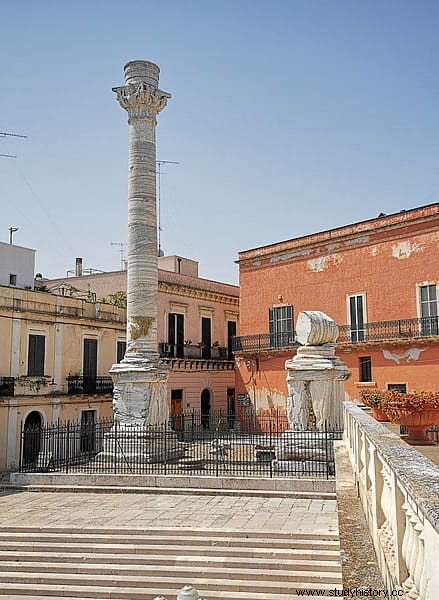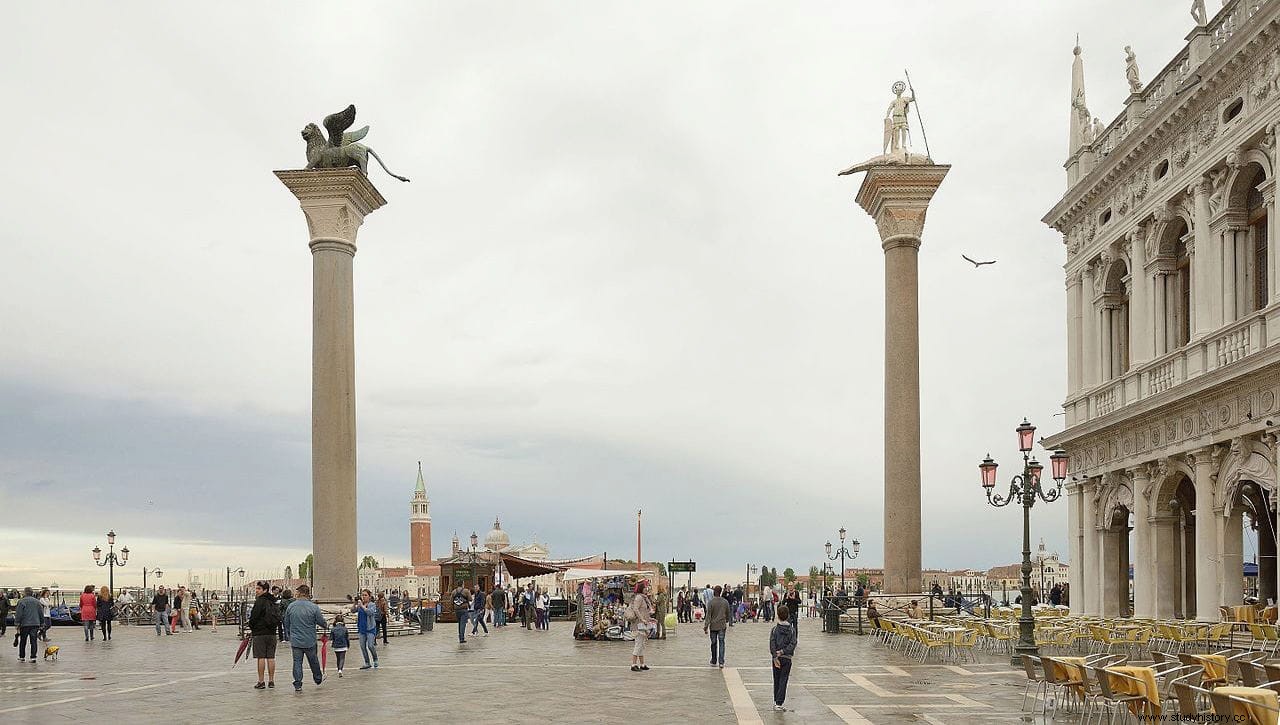Since the 14th century, the city of Brindisi, located on the shores of the Adriatic Sea in the extreme southeast of Italy, has adopted as its emblem two twin columns that stand in the city's port.
We have already seen in previous articles examples of commemorative columns such as Pompey's column in Alexandria or Constantine's column in Constantinople. What is exceptional about the Brindisi columns is that it is the only time that we know of that twin columns were erected in all of Antiquity.
But there is more, because there are numerous doubts, hypotheses and legends about them that make them a small mystery still unsolved. As if that were not enough, one of the columns collapsed in 1528 after a major earthquake, and its fragments were on the ground where they had fallen for more than a century (we'll see what became of them later).

When they were built and what for remains unknown. For a long time it was thought that they could have been the work of Sulla, who landed in Brundisium (Brindisi) in the year 83 BC. to seize power in Rome.
Or perhaps the emperor Trajan, on the occasion of the celebration of the completion of the last section of the Via Trajana, the one that went from Beneventum (Benevento) to Brundisium (Brindisi). The causeway was an extension of the Appian Way that reached Brindisi by a shorter route, and was built in 109 AD. To commemorate the work Trajan had an arch erected in Beneventum, and for this reason it was thought that in Brundisium he did the same with the columns, which would mark the end of the road.

But both the style of the capitals and the diversity of marble used, and reused, in the construction of the columns, as well as the iconography of gods such as telamones (Atlanteans, figures supporting a cornice or capital), indicate that they must be from a later time, mid-2nd or early 3rd century AD. Archaeological excavations in and around the site suggest an even later date.
Its location on a rise overlooking the port of Brindisi, and its visual relationship with the mouth of the port, also led to speculation that they may have been the supports of a kind of lighthouse or lantern placed on a bronze crossbar between the two. But the researchers rule out this possibility as it is absolutely unprecedented and unknown among the types of lighthouses of antiquity.

The most generally accepted hypothesis is that they are commemorative columns, on which there were possibly two lost bronze statues already at the end of Antiquity. Unfortunately, no source mentions who these statues represented or what they commemorated.
Some scholars think that they could represent the columns of Hercules (given that this is the mythical founder of the city). Interestingly, the Venetians erected around 1172 in the Plaza de San Marcos two twin columns crowned by the lion and Saint Theodore, supposedly inspired by those of Brindisi.
As we said before, one of the columns collapsed due to an earthquake on November 20, 1528. The fragments were scattered on the ground at the foot of the base for more than a century, until in 1657 the inhabitants of the nearby town of Lecce, who wanted to build a monument to their patron San Oronzo for having freed them from the epidemic that devastated the kingdom of Naples, requested material to be able to carry it out.

Although the Brindisi were opposed to losing the fragments of their collapsed column, on November 2, 1659, the viceroy of Naples ordered that they be sent to Lecce. With them, the architect Giuseppe Zimbalo put together a new column, even taking advantage of the restored capital (where four female figures were represented) and retouched, on which the statue of San Oronzo was placed. It was inaugurated in 1681 and today it can be seen in the Plaza de San Oronzo in Lecce.
In 1937 from Brindisi it was requested that the column of San Oronzo be returned to the city, to restore the monument as it was originally. But the Superior Council of Fine Arts, following a report by the academic Gustavo Giovannoni, did not consider it possible to return the column, since the rocks and the capital had been reduced and modified by the fall .

The Lecce column reaches 29 meters in height, while the Roman one that still stands in Brindisi is 18.74 meters. The latter was dismantled for the first time during World War II, as a protection measure. In 1996 it would be dismantled again while archaeological excavations were carried out in the surrounding square, which was used to restore it in its entirety.
Once the work was completed, in 2002 it was placed back in its original place, with the exception of the capital (replaced by a copy), which is now exhibited in a room in the Granafei-Nervegna Palace (on Via Duomo in Brindisi). It is decorated with Atlanteans, four gods and eight tritons that are arranged between acanthus leaves, alternating.

Although only one of the columns and the base of the other remain today, the Brindisi columns remain the only known example of twin commemorative columns from Antiquity. Only nobody knows what they commemorated. An inscription on the pedestal of the one that remains standing reads:ILLUSTRIS PIVS ACTIB. ATQ:REFVLGENS – PTOSPATHA LVPVS VRBEM HANC STRVXIT AB IMO – QVAM IMPERATORES MAGNIFICIQ:BENIGNI… (Lupo Protospata, illustrious pious and splendid for his charitable actions, rebuilt this city from the ground up, that the magnificent and benign emperors…). But it is from medieval times, possibly recalling the reconstruction of the city in the 9th century, after the Saracen conquest.
The staircase that goes up to the columns from the port is called Scalinata Virgiliana and it was built in 1861. The name comes from the fact that on the right side of the square, inside a private building, are the remains of the house where the poet Virgilio stayed and died in 19 BC. Who knows if one of the columns was crowned with his effigy?
Fonts
Appian, Civil Wars | Colonne Romane or Porto (Brindisiweb) | Le Colonne Romane di Brindisi (Province of Brindisi) | Wikipedia
